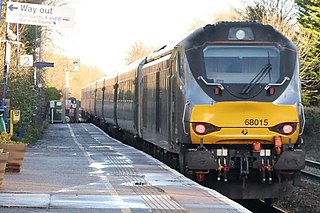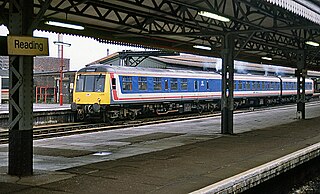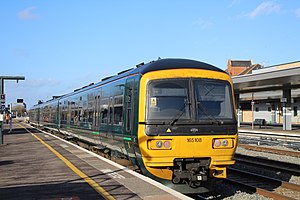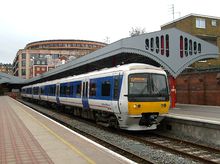
Marylebone station is a Central London railway terminus and connected London Underground station in the Marylebone area of the City of Westminster. On the National Rail network it is also known as London Marylebone and is the southern terminus of the Chiltern Main Line to Birmingham. An accompanying Underground station is on the Bakerloo line between Edgware Road and Baker Street in Transport for London's fare zone 1.

Chiltern Railways is a British train operating company that has operated the Chiltern Railways franchise since July 1996. Since 2009, it has been a subsidiary of Arriva UK Trains.

Great Western Railway (GWR) is a British train operating company owned by FirstGroup that operates the Greater Western passenger railway franchise. It manages 197 stations and its trains call at over 270. GWR operates long-distance inter-city services along the Great Western Main Line to and from the West of England and South Wales, inter-city services from London to the West Country via the Reading–Taunton line, and the Night Riviera sleeper service between London and Penzance. It provides outer-suburban services in West London; commuter services from its London terminus at Paddington to the Thames Valley region, including parts of Berkshire and Buckinghamshire, and Oxfordshire; and regional services throughout the West of England and South Wales to the South coast of England. Great Western Railway provides and maintains the Electrostar Class 387 fleet for Heathrow Express.

Network SouthEast (NSE) was one of the three passenger sectors of British Rail created in 1982. NSE mainly operated commuter rail trains within Greater London and inter-urban services in densely populated South East England, although the network went as far west as Exeter and also covered the inner East of England. Before 1986, the sector was originally known as London & South Eastern.

First Great Western Link (FGWL) was a train operating company in England owned by FirstGroup that operated the Thames franchise from April 2004 until March 2006.

The British Rail Class 121 is a single-car double-ended diesel multiple unit. 16 driving motor vehicles were built from 1960, numbered 55020–55035. These were supplemented by ten single-ended trailer vehicles, numbered 56280–56289. They have a top speed of 70 mph, with slam-doors, and vacuum brakes. The driving motor vehicles were nicknamed "Bubble Cars" by some enthusiasts.

The British Rail Class 166 Networker Turbo is a fleet of diesel multiple unit (DMU) passenger trains, built by ABB Transportation at their Holgate Road Works in York between 1992 and 1993. They were specified by and built for British Rail, the state-owned railway operator in Great Britain at the time. The trains were designed as a faster, air-conditioned variant of the Class 165 Turbo, intended for longer-distance services, and, like the 165s, belong to the Networker family of trains. They were originally known as Networker Turbos to distinguish them from the electrically propelled members of that family. Today the 166s, alongside the 165s, are normally referred to as Thames Turbos or just simply Turbos.

The Chiltern Main Line is a railway line which links London (Marylebone) and Birmingham, the United Kingdom's two largest cities, by a 112-mile (180 km) route via High Wycombe, Bicester, Banbury, Leamington Spa and Solihull.

The Greenford branch line is a 2 miles 40 chains (4.0 km) Network Rail suburban railway line in west London, England. It runs northerly from a triangular junction with the Great Western Main Line west of West Ealing to a central bay platform at Greenford station, where it has cross-platform interchanges to the London Underground's Central line. A triangular junction near Greenford connects to the Acton–Northolt line. The line serves mainly the suburbs of Ealing and Greenford.

Newport is the second-busiest railway station in Wales, after Cardiff Central). It is situated in Newport city centre and 158 miles 50 chains (255.3 km) from London Paddington, via Stroud.

Aylesbury railway station is a railway station in Aylesbury, Buckinghamshire, England, on the London–Aylesbury line from London Marylebone via Amersham. It is 38 miles (61 km) from Aylesbury to Marylebone. A branch line from Princes Risborough on the Chiltern Main Line terminates at the station. It was the terminus for London Underground's Metropolitan line until the service was cut back to Amersham in 1961. The station was also known as Aylesbury Town under the management of British Railways from c. 1948 until the 1960s.

The Class 168Clubman is a British diesel multiple unit (DMU) passenger train used on Chiltern Line services between London Marylebone and the West Midlands. The trains were built by Adtranz at the Derby Litchurch Lane Works in several batches from 1998.

The London–Aylesbury line is a railway line between London Marylebone and Aylesbury, going via the Chiltern Hills; passenger trains are operated by Chiltern Railways. Nearly half of the line is owned by London Underground, approximately 16 miles (26 km) – the total length of the passenger line is about 39 miles (63 km) with a freight continuation.

The British Rail Class 115 diesel multiple units were 41 high-density sets which operated the outer-suburban services from Marylebone usually to destinations such as High Wycombe, Aylesbury and Banbury which are on the Chiltern Main Line and Great Central Main Line. Sometimes, these sets used to operate 8- or 12-car-long expresses to Nottingham Victoria in the final years of the GCML. Coincidentally, Class 115 units operated services under Table 115 in the British Rail timetable.

The British Rail Class 119 DMUs were used throughout the Western Region and on services in the Midlands sourced by Tyseley Depot. Built by the Gloucester Railway Carriage & Wagon Co. Ltd, the body design was based on the Swindon Cross-Country sets, but with a Derby cab. Sets were normally formed of three cars.

Monks Risborough railway station is a small, single platform railway station of the village of Monks Risborough in Buckinghamshire, England.

The British Rail Class 172 is a British diesel multiple unit (DMU) passenger train from the Turbostar family, built by Bombardier Transportation's Derby Litchurch Lane Works for use on inner-suburban passenger services. The class is currently operated by West Midlands Railway.

The Networker is a family of passenger trains which operate on the UK railway system. They were built in the late 1980s and early 1990s by British Rail Engineering Limited and Metro Cammell. The trains were built for the Network SouthEast (NSE) sector of British Rail, which is where their name comes from. They are all multiple-unit trains.

Diesel multiple units and railcars are trains, usually with passenger accommodation, that do not require a locomotive. Railcars can be single cars, while in multiple units cars are marshalled together with a driving position either end. As of December 2010, 23 percent of the rail passenger cars used on Network Rail are part of a diesel multiple unit.

Network SouthEast (NSE), the sector of British Rail which ran passenger services in London and southeast England between 1986 and 1994, operated a wide variety of rolling stock during its existence. The majority of the network was electrified, and further electrification schemes took place during the 1986–1994 period; and the 7,000 vehicles owned by NSE in 1986 consisted of a mixture of electric, diesel-electric and diesel multiple units, diesel locomotives and the coaches they hauled.





























